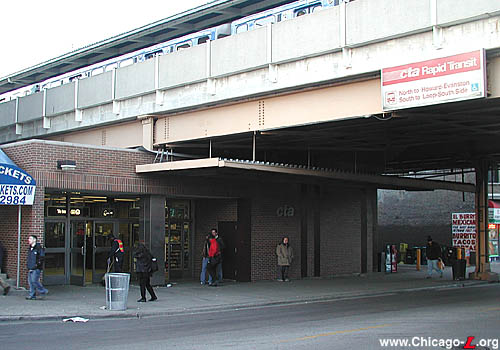
The front of Addison
station, looking northeast on May 3, 2003. The front facade
is very plain, clad in light brown/tan brick with a
stainless steel CTA logo. Across the street is an auxiliary
exit from the platform to the south side of Addison Street.
For a larger view, click here.
(Photo by Graham Garfield)
|
Addison
(3600N/940W)
Addison Street and
Sheffield Avenue, Wrigleyville (Lakeview)
Service
Notes:
|
Red Line: Howard |
|
Accessible Station |
|
Owl Service |
Quick Facts:
Address: 940 W. Addison
Street
Established: June 6, 1900
Original Line: Northwestern Elevated Railroad
Previous Names: none
|
Skip-Stop Type:
|

|
Station
|
Rebuilt: 1994
Status: In Use
History:
The path of the initial section of the Northwestern Elevated Railroad, from Lake and Wells Streets to Broadway and Wilson on the what was then the far North Side, was cleared in 1895 and erection of the steel was begun January 23, 1896. Financial difficulties delayed construction several times, necessitating extensions of deadlines for commencement of service in the company's franchise with the city. All-night shifts were eventually required to complete the structure on Christmas Day 1899, days before their deadline to begin service. But most of the stations were incomplete December 31 and, after some negotiating, another extension was obtained. Northwestern Elevated service between the Loop and Wilson began on May 31, 1900. However, due to a two-week strike construction was not complete at all stations1. As a result, seven stations, including Addison, opened 1-2 weeks after the inauguration of "L" service. Addison station finally opened for service on June 6, 19002.
The only line in Chicago to do so, the
Northwestern "L" built four tracks north of Chicago Avenue to allow
for both local and express service. Some stations, like Addison, were
built with platforms on the outside tracks (for locals only), but
some had two island platforms to facilitate both express and local
trains.
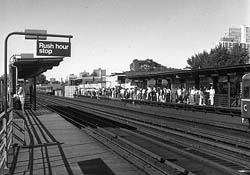
A post-game crowd stands on
the outbound Addison platform looking north in 1989, as a
northbound North-South train trailed by a 2000-series car
that just departed is in the distance and another train led
by a 2600-series car is approaching on the right. For a
larger view, click here.
(CTA photo)
|
The original brick station house was similar to those still at Chicago, Sedgwick,
Armitage and Fullerton.
Their architecture was standard for brick ground-level station houses
built on what was the Northwestern mainline. They were designed by
William Gibb and constructed entirely of brick with terra-cotta trim
and stone. The bold modeling of the details is characteristic of
Italianate work of the late 19th century, though these station might
better be classified as Classical Revival.
The interior featured plaster walls with extensive wood detailing in the door and window frames, ceiling moldings, and tongue-in groove chair rail paneling. The interior also featured an ornate, intricately-detailed ticket agent's booth with paneled walls, dentils ands moldings around the top, and ornate metal grill over the window used by the ticket agent.
The dual side platforms at Addison were typical of those the Northwestern built for its local stations, with wooden decks and covered in the center by peaked-roof canopies of steel supports with a gently-curved bracket and intricate latticework, covered by a corrugated metal roofing. Originally, these covered about half the platform length, but the platforms were subsequently lengthened multiple times to allow longer trains to berth. The platforms had railings which consisted of tubular railings and posts with panels of decorative, ogee patterned metalwork inside. The platforms were outboard of the outer of the line's four tracks, served by local trains and inaccessible by the expresses utilizing the inner tracks.
Addison station's traffic increased after the baseball field now
known as Wrigley Field was was built in 1914 a half block west of the
station. Originally known as Weeghman Park, the stadium, built on
grounds once occupied by a seminary, was the home of Chicago's
Federal League baseball team (known as both the Federals and the
Whales). After the Federal League folded for financial reasons
following the 1915 season, park owner Charles H. Weeghman purchased
the Cubs team and moved them from a West Side field to his
two-year-old ballpark at Clark and Addison. The first National League
game at the ballpark was played April 20, 1916. The park became known
as Cubs Park in 1920 after the Wrigley family purchased the team from
Weeghman and was renamed Wrigley Field in 1926 in honor of William
Wrigley Jr., the club's owner. Now the second-oldest ballpark in the
major leagues behind Boston's Fenway Park, the "Friendly Confines"
has been the site of such historic moments as Babe Ruth's "called
shot" (when Ruth allegedly pointed to a bleacher location during Game
3 of the 1932 World Series and then hit a home run off the next
pitch).
Addison had been designed as a local station for the Northwestern
Elevated, meant to serve a residential neighborhood. The amount of
traffic generated by the adjacent ballpark by far overwhelmed the
capacity of the station, with its modest station house and narrow
stairs. The CTA and its
private predecessors did the best they could to modify the station to
accommodate the tremendous gameday crowds, including addicting an
extra set of stairs to each platform north of the original stairs and
adding auxiliary ticket agents booths outside to the west of the
station house, which were closed off with swinging gates during
non-game days and opened when home games were played. Still, the
narrow side platforms and jury-rigged station were only
minimally-sufficient for baseball traffic. Nevertheless, few things
are as uniquely Chicagoan as being able to stand on the Addison
platform and see the infield from the elevated, or the sight of the
"L" from inside the park.
In the North-South service revision of 1949, Addison became a B
station in the A/B skip-stop scheme. Howard trains ran on the inside
local on the old "express" tracks (tracks 2 & 3) and Evanston
Express trains on the outside "local" tracks (tracks 1 & 4). This
worked well north of Addison where just about all stations have
island platforms between tracks 2 and 3, but Addison had side
platforms, creating an irksome situation in which Howard B trains had
to be routed through interlockings north and south of the station
onto the Evanston Express side tracks to access the station
platforms.
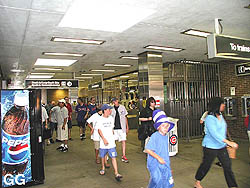
The interior of Addison
station, looking north from the Addison entrance in July
2001. On game days like this, the station can become
very crowded, far more than in this view over an hour
before the first inning. For a larger view, click
here.
(Photo by Graham Garfield)
|
This bothersome arrangement was rectified in 1994 when the Addison
was rebuilt with a new station house, platform and a rebuilt track
structure. The project was part of a larger set of capital
improvements made as part of the realignment of the North-South and
West-South through-routes, which paired the Howard and Dan Ryan lines
to create the Red Line. The original station house was demolished and
a new tan brick utilitarian structure was built. The track
arrangement was simplified by demolishing the side platforms and
building an island platform between the center tracks, allowing all
Howard trains to stay on tracks 2 and 3 the whole way through the
North Side. Although the details were somewhat different, the overall
form and design followed that set forth by the stations of the
then-new Orange Line stations, which opened in 1993. To accommodate
the island platform, the space between the center tracks had to the
widened, so the two northbound tracks (3 & 4) stayed on the
original steel structure and the southbound tracks (1 & 2) were
placed on a new concrete deck with direct track fixation instead of
the standard cut spikes and tie plates on the steel-deck elevated.
While this concrete structure was being built, southbound Evanston
and Howard trains ran on track 3 until August 19, 1994, when both
where shifted onto track 1 on the new decking. On August 21,
southbound Howard trains moved onto their permanent home on track 2.
The new island platform had opened earlier in the summer.
Addison is the station for Wrigley Field, home of the beloved
Chicago Cubs. Chicago artist Steve Musgrave, who is regularly
commissioned by the CTA to
design promotional posters for the annual crosstown classic played
between the Chicago Cubs and the Chicago White Sox, adopted the
Addison station as part of the
CTA's Adopt-A-Station program
in 1998. Musgrave has several murals on display at the Addison
station, which feature Cubs legends Billy Williams, Ferguson Jenkins,
Ryne Sandberg and "Mr. Cub," Ernie Banks (who, in an interesting side
note, served on the CTA board
between 1969 and 1981). In addition to the baseball themed work for
the CTA, Musgrave designed the
cover art for the 2002 and 2003 Chicago Cubs programs.
Addison is one of five Chicago Transit Authority sites that are
planned to provide access to vehicles belonging to I-GO, a
car-sharing program. At their August 11, 2004 meeting, the Chicago
Transit Board approved the agreement between the
CTA, the Center for
Neighborhood Technology (CNT) and its affiliate I-GO Car Sharing
(I-GO) to promote the use of public transportation by providing
additional options for public transit users. The agreement
establishes a yearlong pilot program where members can access I-GO
vehicles at locations adjacent to or near public transportation.
During Autumn 2004 and Spring 2005, several "L" stations got new
station name signs. As part of a multi-station program, twelve
facilities in all on the Blue, Purple, Red, Orange, and Green lines
received new, Green Line
Graphic Standard station name signs, replacing older KDR-type
signs that used an outdated graphic scheme that was inconsistent with
the colored line names. The new signs were added at additional
locations outside the tracks, facing to the platform, for ADA
compliance. The new additional signs outside the tracks were mounted
on new steel brackets that are supported and project from below. New
signs did not replace the old ones in existing locations in the
windbreaks, so at the conclusion of the project there was a mixture
of old KDR
signs and new Green Line
Graphic Standard signs. Installation at all stations was complete
by the end of November 2004. Fabrication and installation of the
signs was performed by contractor Western Remac.
In 2006, the station received additional signage improvements. New
entrance signs installed as part of a signage upgrade project on the
Red Line. As part of this effort, the station also received granite
compass roses inset into the sidewalk in front of the station
entrance to assist customers leaving the station to navigate their
way, and three-sided galvanized steel pylons in the station house and
on the platform to display maps and station timetables.
As CTA continued the Wilson Station Reconstruction Project, track 1 -- the westernmost, southbound Purple Line Express track -- was closed for demolition over the weekend of March 6, 2015. This began a multi-year period of three-track operations through Wilson station, similar to the operations for construction phasing that took place at Belmont and Fullerton in 2007-08 for those stations's reconstruction. Three-track operations began Monday, March 9, 2015.
Southbound Red Line and Purple Line Express trains share a single track -- track 2 -- between Lawrence and Belmont for one year, with Purple Line trains merging onto track 2 through a new crossover at Leland whose installation was completed over the weekend before three-track operations began. Although the right-hand crossover from track 2 back to track 1 at Montrose is outside of the construction zone and remained in service, it is a non-interlocked hand-throw switch, making its use to re-sort trains slow and likely to cause excessive delays given the close headway of the combined Red and Purple lines. As such, Purple Line trains were kept on track 2 all the way to Clark Junction, where they were sorted back onto track 1 by the tower. Because they were on the same track as the Red Line, and might likely catch up to their Red Line leader on the same track if they ran express, as well for added customer convenience, Loop-bound Purple Line Express trains added stops at the Wilson, Sheridan and Addison stations during this phase of the project, but during morning rush only. Loop-bound trains in the evening rush, as well as all Linden-bound trains, continued to bypass those three stations.
Purple Line Express trains discontinued stopping at Addison weekday mornings effective Monday, March 21, 2016, when the Wilson Station Reconstruction Project moved into phase 2. At that point, the new track 1 opened through Wilson station and southbound Red and Purple Line trains moved to using this track. At Addison Interlocking, north of Addison station, Red Line train were sorted and moved back onto track 2 to call at Addison, but Purple Line trains remained on track 1, as they had before, bypassing the station.
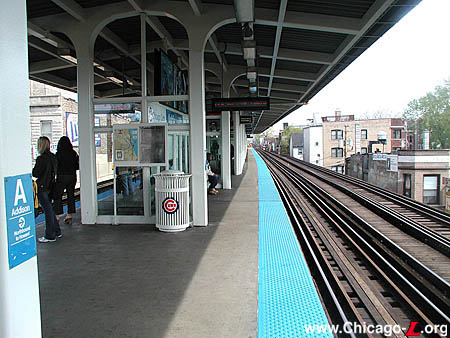
The island platform at
Addison, looking north on May 8, 2003. The northbound tracks
to the right are on the original right-of-way; The original
southbound tracks, moved west in the reconstruction, were
where the platform is now. Although the station is simply
called "Addison", Cubs logos adorn everything from station
name signs to garbage cans. For a larger view, click
here.
(Photo by Graham Garfield)
|

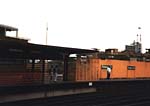
|
addison10.jpg
(114k)
Addison station started life as a typical Northwestern
Elevated local station, similar to Diversey
or Armitage, but over the years
was heavily modified. In large part, the presence of Wrigley
Field and the massive crowds it brought were responsible.
Changes included the replacement of nearly all the original
railings and the installation of tall barriers and the
addition of a third set of stairs down from each side
platform to help move crowds on and off the relatively
narrow platforms quicker. By July 1992, as seen here, the
station was getting deteriorated and could no longer support
the level of use it received. (Photo by Tony
Nowikowski)
|

|
cta2457.jpg
(51k)
Car 2457 leads a Jackson Park-Howard "B" train of other
2400s past Addison
station on November 1, 1980. The Wrigley Field scoreboard is
poking above the buildings in the upper left corner. In
1995, the car was sent to Delaware for repair for fire
damage the car suffered. (Photo by Roy G.
Benedict)
|
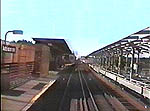
|
addison01.jpg
(55k)
Addison station is seen here in 1994 while it was being
reconstructed. This included replacing the side platforms
with an island one and a concrete deck instead of a steel
structure. Northbound trains here are rerouted to track 2
while 3 & 4 are being rebuilt. (Photo
from Chicago's "L"/Subway System: Take a Ride on the Wild
Side from All-the-6000s-You-Missed
Productions)
|
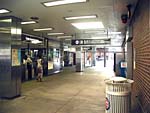
|
addison04.jpg
(177k)
The interior of Addison station, seen here looking south on
June 25, 2003 in the unpaid area, has a layout that is
basically the same as the similarly laid out Orange Line
stations that opened less than a year before new the Addison
facility did. As at those stations, the fare controls are
set perpendicular to the vertical access pathways to the
island platform. The agent's booth is also similar.
(Photo by Graham Garfield)
|
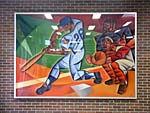
|
addison06.jpg
(182k)
Chicago artist Steve Musgrave, who adopted Addison station,
has several murals on display in the station that depict
famous Cubs players. This one in the unpaid area near the
primary (south) entrance, seen here on June 25, 2003,
depicts Billy Williams, one of the best players in Cubs
history. He was the NL Rookie of the Year in 1961 and a
six-time All-Star, and he was inducted into the Hall of Fame
in 1987. Called "Sweet-swinging Billy Williams" because of
his near-perfect swing, he hit at least 20 home runs for 13
straight seasons. He and Ernie Banks are the only Cubs to
have their uniform numbers retired. He joined the Cubs'
coaching staff in 1980. (Photo by Graham
Garfield)
|
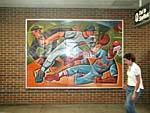
|
addison07.jpg
(195k)
Another of Musgrave 's murals is near the north entrance to
the station, in the unpaid area, seen here on June 25, 2003.
Ryne Sandberg, widely considered the best second baseman of
his era and arguably the best ever, is depicted going
toe-to-toe with one of the St. Louis Cardinals, referencing
one of his career-defining moments: On a June 23, 1984
afternoon, Sandberg tied the Cardinals with homers in both
the ninth and 10th innings, his 5-for-6 afternoon with seven
RBI helping the Cubs eventually win 12-11 in overtime. He is
the only second baseman in major-league history to claim
nine Gold Gloves and in played in the 1984 All-Star Game.
(Photo by Graham Garfield)
|
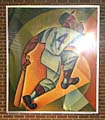
|
addison08.jpg
(189k)
Over the south stairs from the station house to the platform
is Musgrave 's mural of Ernie Banks, seen here on July 2,
2003. Ernie Banks, the man known as "Mr. Cub", was a twenty
year veteran of the sport who played and coached for the
Cubbies from 1953 to '73. Banks is the Cubs' all-time leader
in games played (2,528), at-bats (9,421), home runs (512),
total bases (4,706) and extra-base hits (1,009); ranks
second in hits (2,583) and RBIs (1,636); third in years (19)
and doubles (407); and fifth in runs (1,305) and singles
(1,574). Six years after retiring from the major leagues as
a lifelong Cub in 1971, Banks was elected into the Hall of
Fame in his first year of eligibility, inducted at
Cooperstown in 1977. Mr. Cub coached for the Cubs until 1973
and also worked in the club's front office. His uniform #14
was the first retired by the Cubs organization and currently
flies on game days from the left field foul pole. Banks also
served on the CTA
board between 1969 and 1981. (Photo by
Graham Garfield)
|
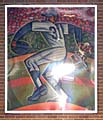
|
addison09.jpg
(209k)
Musgrave 's fourth mural, depicting Ferguson Jenkins, is
over the north stairs from the station house to the
platform. Fergie Jenkins, who was traded to the Cubs in
1966, won 20 or more games 6 consecutive seasons, from 1967
through 1972. Jenkins led the National League in complete
games with 20 in 1967, 24 in 1970, and 30 in 1971; in
strikeouts with 273 in 1969; and in victories with 24 and
innings pitched with 325 in 1971. He played in two All-Star
games -- 1967 and 1971 -- and won the National League's Cy
Young Award in 1971. Jenkins was traded to the Texas Rangers
in 1973, but finished his career with the Cubs in 1982 and
1983. Jenkins had a career record of 284 wins and 226
losses, with 49 shutouts and a 3.34 ERA. He struck out 3,192
hitters while walking only 997 in 4,500 2/3 innings.
Although Fergie Jenkins is one of he Cubs' best players, he
rarely received the note that his accomplishments warrant.
(Photo by Graham Garfield)
|
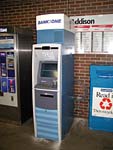
|
addison-ATM.jpg
(154k)
Following the CTA Board's approval of the program in August
2003, Automated Teller Machines (ATMs) were installed in 11
rail stations around the 1st of December. Bank One, who owns
and maintains the ATMs, pays the
CTA a percentage of
the ATM user fees collected at the stations, creating an
additional source of revenue for the Authority. One of the
ATMs is seen here in the unpaid area of Addison station on
December 2, 2003. The ATMs are installed outside of the paid
area of the stations so individuals not using the "L" also
have access to them. (Photo by Graham
Garfield)
|
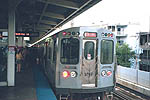
|
cta2747.jpg
(71k)
Rehabbed car 2747 brings up the rear of a southbound Red
Line train at Addison on Sunday September 10,
2000. (Photo by Ernie
Baudler)
|
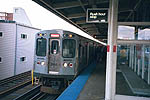
|
cta2740b.jpg
(72k)
Car 2740 leads a Howard-bound Red
Line train at Addison on Sunday September 10, 2000.
(Photo by Ernie Baudler)
|

|
cta2740c.jpg
(61k)
Another view of 2740 at Addison on September 10,
2000. (Photo by Ernie Baudler)
|
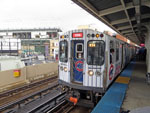 |
cta5696-Cubs02.jpg (232k)
Although originally advertised as planned to be wrapped for a limited time, the Cubs World Series cars remained wrapped all winter and through the beginning of the Cubs' 2017 season. Here, car 5696 leads a Red Line train in its Cubs wrap stopping at Addison -- the stop for Wrigley Field -- on the day of the Cubs' home opener, April 10, 2017. (Photo by Graham Garfield) |

- addison.wav
(58K): Conductor announcement: "Northbound Howard 'B',
Addison is the next stop..."
.
- Addison_Red_next.wav
(267k): "Addison is next. Doors open on the left at
Addison. Standing passengers: please do not lean against the
doors." (Sound courtesy
of Tony Coppoletta)
.
- Addison_next-Purple.wav
(487k): A manual Purple Line announcement for Addison, a
weekday Cubs game day-only stop: "Hello passengers: This is a
regular train going to Addison. Once this train leaves Howard, our
next stop will be Addison, Cubs game and Wrigley Field. Once
again, once this Purple Line train leaves Howard Street, our next
stop will be Addison, Wrigley Field Cubs game."
(Sound courtesy of Tony Coppoletta)
Notes:
1. "ENDS STRIKE ON NEW "L"." Chicago Daily Tribune, 8 May 1900: 1.
2. "BOYS MEDDLE WITH “L” TRACK." Chicago Daily Tribune, 7 June 1900: 12.


















